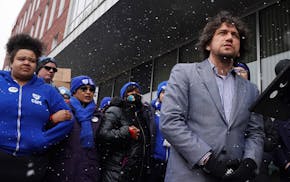As the pandemic's economic shockwaves recede, Twin Cities communities hashing out their 2024 budgets are finding themselves with more money to spend — and many are opting to put it into their fire departments.
Whether it's building new stations or hiring more firefighters — and offering higher pay as cities compete for job candidates — the new spending means fire department budgets across the metro area will likely take up a bigger slice of budgets next year. City officials say the extra spending is needed as the number of emergency calls climbs and equipment costs spike.
In Bloomington, the department's proposed 2024 budget rose by nearly $1.6 million from 2023 — almost a quarter of the city's overall $7 million budget increase. The police department budget increase is just under $2 million.
"Next year's budget is a public safety budget for the city," said Bloomington Fire Department Chief Ulie Seal.
Other cities are seeing similar challenges, and similar costs taking a bite out of the growing revenue from rising property values. The biggest driver of increased fire departments costs is pay, which is rising as simultaneously growing departments compete for firefighters.
Edina Fire Chief Andrew Slama said Minnesota departments are hiring in response to call volumes, and making up for historical understaffing. At the same time, he said, "the pool of candidates continues to become smaller."
Many departments that used to rely on part-time paid on-call firefighters are shifting to full-time firefighters, and competing for those recruits, since fewer and fewer people want to work as part-time firefighters. Pay for remaining paid on-call firefighters is rising quickly, too, Seal said.
"If you're paying them sub-$20 an hour to get up in the middle of the night to go fight fires, they can make more money and get better hours at a less risky part-time job," he said.
Firefighters aren't the only city workers getting pay raises, city budget officials say. Employee unions including police, fire and City Hall staff are bargaining for higher salaries. And even non-union staff are being hired for higher pay than in years past.
"Due to the tight labor market, many positions are being hired at the mid/top end of pay ranges which traditionally were filled at the lower end," a presentation to Richfield's City Council last month read.
"Certainly, the need to increase wages is really impacting our budget," Roseville City Manager Patrick Trudgeon said. "You really have to be an attractive employer, pay good wages and have good climate."
Fire departments across the Twin Cities are trying to expand to keep pace with ever-rising numbers of emergency calls — part of a nationwide trend — that comes as departments brace for retirements.
After a record number of calls in 2022, Richfield Fire Chief Mike Dobesh said, the small city is on pace for another record in 2024.
Bloomington counts 120 firefighters, who are mostly part-time.
"That ain't enough," Seal said, to staff six fire stations around the clock and protect 90,000 residents, homes and businesses including the Mall of America. "We want to make sure people get the services they need when they need them."
Other fire department costs have spiked since the pandemic.
Dobesh said the cost of turnout gear for new hires has jumped from $2,800 to $4,200. A pumper truck that cost Richfield over $800,000 in 2021 — and that the city is still waiting for — would cost well over $1 million if ordered today.
Though costs are going up, Seal said it's hard to justify making cuts that would affect service.
"They expect someone to come when you call 911," he said.
Bloomington is trying to hire six full-time firefighters a year for the next several years, after bringing on 24 full-timers this year.
Other departments have similarly ambitious goals. Minnetonka is looking for three firefighters next year and a total of 18 in the next few years.
Fire departments are also building or renovating fire stations. A new $12.5 million station opened in Bloomington this summer. Edina is building a new station, too, and the city's finance department estimated the debt service to pay down that station would be $2.3 million in 2025 alone. And Golden Valley hopes to use a sales tax for a new public safety building, if voters approve it in November.
Federal funding is taking the edge off some costs, for now.
Edina and Bloomington have both received the federal grant known as SAFER to pay firefighters, and Maplewood is hoping to receive the same grant later this year. In Bloomington, Seal said, 18 of the 24 full-time firefighters hired this year are paid with that money.
"When that grant runs out in three years, those 18 firefighters will hit the tax rolls," he said.
In Edina, Slama said the six firefighters hired in 2020 using grant money will be paid out of the city's general fund in 2024. The grant steps from paying for 75% of the firefighters' salaries in 2021 and 2022 to 25% this year, so it won't be a huge shock. But Edina is still hoping to get the funding renewed.
But Seal said he understands that elected officials balance competing priorities.
"It has to come down to, what kind of community do you think you want to live in," Seal said, "and what are you willing to pay to live in that kind of community?"

Lakewood Cemetery in Minneapolis opens new Welcome Center
Man killed in domestic incident in Coon Rapids, Sheriff's Office says

U of M's interim president meets with pro-Palestinian protest leaders

Legendary boys hockey coach Randolph loses his job

